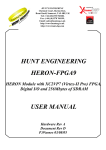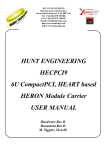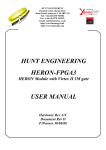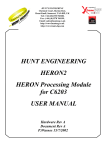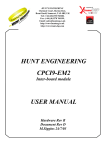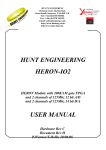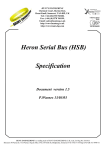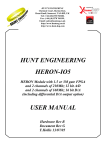Download HUNT ENGINEERING HERON
Transcript
HUNT ENGINEERING Chestnut Court, Burton Row, Brent Knoll, Somerset, TA9 4BP, UK Tel: (+44) (0)1278 760188, Fax: (+44) (0)1278 760199, Email: sales@hunteng co.uk http://www.hunteng.co.uk http://www.hunt-dsp.com HUNT ENGINEERING HERON-BASE1 HERON module carrier with single HERON module slot. USER MANUAL Hardware Rev A Document Rev A P.Warnes 12/10/01 COPYRIGHT This documentation and the product it is supplied with are Copyright HUNT ENGINEERING 2001. All rights reserved. HUNT ENGINEERING maintains a policy of continual product development and hence reserves the right to change product specification without prior warning. WARRANTIES LIABILITY and INDEMNITIES HUNT ENGINEERING warrants the hardware to be free from defects in the material and workmanship for 12 months from the date of purchase. Product returned under the terms of the warranty must be returned carriage paid to the main offices of HUNT ENGINEERING situated at BRENT KNOLL Somerset UK, the product will be repaired or replaced at the discretion of HUNT ENGINEERING. If HUNT ENGINEERING decides that there is any evidence of electrical or mechanical abuse to the hardware, then the customer shall have no recourse to HUNT ENGINEERING or its agents. In such circumstances HUNT ENGINEERING may at its discretion offer to repair the hardware and charge for that repair. Exclusions - Limitations of Liability - HUNT ENGINEERING makes no warranty as to the fitness of the product for any particular purpose. In no event shall HUNT ENGINEERING’S liability related to the product exceed the purchase fee actually paid by you for the product. Neither HUNT ENGINEERING nor its suppliers shall in any event be liable for any indirect, consequential or financial damages caused by the delivery, use or performance of this product. Because some states do not allow the exclusion or limitation of incidental or consequential damages or limitation on how long an implied warranty lasts, the above limitations may not apply to you. TECHNICAL SUPPORT Technical support for HUNT ENGINEERING products should first be obtained from the comprehensive Support section http://www.hunteng.co.uk/support/index.htm on the HUNT ENGINEERING web site. This includes FAQs, latest product, software and documentation updates etc. Or contact your local supplier - if you are unsure of details please refer to http://www.hunteng.co.uk for the list of current re-sellers. HUNT ENGINEERING technical support can be contacted by emailing [email protected], calling the direct support telephone number +44 (0)1278 760775, or by calling the general number +44 (0)1278 760188 and choosing the technical support option. 2 HUNT ENGINEERING HERON-BASE1 USER MANUAL TABLE OF CONTENTS INTRODUCTION.......................................................................................................... 4 PHYSICAL LOCATION OF ITEMS ON THE HERON-BASE1............................ 5 MOUNTING OF THE HERON-BASE1 ..................................................................... 6 GETTING STARTED ................................................................................................... 7 BOARD FEATURES ..................................................................................................... 8 FIFO CLOCKS .......................................................................................................................................... 8 MODULE ID............................................................................................................................................. 8 CARRIER ID............................................................................................................................................. 8 RESET...................................................................................................................................................... 8 ADDRESS/FLAGSEL.................................................................................................................................. 8 CONFIG.................................................................................................................................................... 9 POWER CONNECTOR ................................................................................................................................ 9 POWER CABLE ......................................................................................................................................... 9 I/O CONNECTOR ...................................................................................................................................... 9 Connector type................................................................................................................................... 9 Connector Pin out............................................................................................................................ 10 PROCESSOR JTAG CONNECTOR ............................................................................................................ 10 Connector Pin out............................................................................................................................ 11 ESD PROTECTION .................................................................................................................................. 11 PHYSICAL DIMENSIONS OF THE BOARD ................................................................................................. 11 POWER REQUIREMENTS OF THE HERON-BASE1................................................................................. 11 FITTING MODULES TO YOUR CARRIER .......................................................... 12 TROUBLESHOOTING .............................................................................................. 13 HARDWARE ........................................................................................................................................... 13 FPGA MODULES ................................................................................................................................... 13 DSP MODULES ...................................................................................................................................... 13 CE MARKING ............................................................................................................. 14 TECHNICAL SUPPORT............................................................................................ 15 3 HUNT ENGINEERING HERON-BASE1 USER MANUAL Introduction The HERON module is a module defined by HUNT ENGINEERING to address the needs of our customers for real-time DSP systems. The HERON module is defined both mechanically and electrically by a separate HERON module specification that is available from the HUNT ENGINEERING CD, via the user manual section from the CD browser, or online from http://www.hunteng.co.uk and going to the application note section under the user area. The HERON module specification also defines the features that a HERON module carrier must provide. HERON stands for Hunt Engineering ResOurce Node, which tries to make it clear that the module is not for a particular processor, or I/O task, but is intended to be a module definition that allows “nodes” in a system to be interconnected and controlled whatever their function. In this respect it is not like the TIM-40 specification which was specific to the ‘C4x DSP. As the HERON-BASE1 was developed, HUNT ENGINEERING have already developed HERON modules carriers like the HEPC8, HERON processor modules (that carry various other members of the TMS320C6000 family of DSP processors from TI), and HERON-FPGA and HERON-IO modules with Xilinx FPGAs. The HERON module is able to connect to the carrier board through several standard interfaces. • The first is a FIFO input interface, and a FIFO output interface. This is to be used for the main inter-node communications. (It is usually also used for connection to the HOST computer if any). • The second is an asynchronous interface that allows registers etc to be configured from a HERON module. This is intended for configuring communication systems, or perhaps to control some function specific peripherals on the carrier board. • The third is a JTAG (IEEE 1149.1) interface for running processor debug tools. • The Fourth is the HERON Serial Bus, used for configuration messages. • The last is the general control such as reset, power etc. HUNT ENGINEERING defined the HERON modules in conjunction with HEART – the Hunt Engineering Architecture using Ring Technology. This is a common architecture that we will adopt for our HERON carriers that provides good real time features such as low latency and high bandwidth, along with software reconfigurability of the communication system, multicast, multiple board support etc., etc. However, it is not a requirement of a HERON module carrier that it implements such features. The HERON-BASE1 is HERON module that has a single HERON module slot, and no Host bus connection. It is intended to allow the stand alone use of a single HERON module. This is ideal for mounting a module that has FPGA and I/O (like the HERON-IO2) but has been designed to accept a single C6000 based module too. The HERON-BASE1 can be used in a laboratory type environment, or can be mounted inside another piece of equipment. It is intended as a low cost way of embedding a HERON module. 4 HUNT ENGINEERING HERON-BASE1 USER MANUAL Physical Location of Items on the HERON-BASE1 4 HERON-BASE1 mounting holes Power good LEDs Processor JTAG connector Power connector HERON connector HERON connector HERON connector HERON connector Carrier jumpers ID I/Os connector 3.3V regulator Reset and Config LEDs 5 HUNT ENGINEERING HERON-BASE1 USER MANUAL Mounting of the HERON-BASE1 The HERON-BASE1 can be operated standing on a table or bench. It has small rubber feet to make it more stable and to prevent damage of components on the bottom of the board. However it is expected that most users will eventually fix the board to something, making a more permanent installation. For this reason mounting holes are provided in the PCB. 5.0” (127mm) 4.8” (121.92mm) 0.2” (5.08mm) 2.5” (63.5mm) 2.3” (58.42mm) 0.2” (5.08mm) These holes are 125 thou diameter, so accept a 3mm fixing with a suitable clearance. These four holes are separate from the mountings of the HERON module. 6 HUNT ENGINEERING HERON-BASE1 USER MANUAL Getting Started The HERON-BASE1 is a stand alone module carrier, so all you need to do is fit the module that you will use, and apply power. Note that just like the HERON module there are +5V, +12V and –12V power supply connections to the HERON-BASE1. You need only connect the power supplies that are needed for the module you are using. As an example if you are using the HERON-IO2, you do not need to connect –12V as the module does not need it. All power supplies have LEDs to show when they are active, so only the LEDs for the supplies connected should be alight. The HERON-BASE1 generates a +3.3V supply for use in driving some of the signals to the HERON module slot. This LED should always be lit. The HERON-BASE1 is designed to provide a reset to the HERON module when the +5V supply is switched on. A reset can be forced by joining two pins on the I/Os connector. This input is de-bounced so a simple reset switch can be connected that simply joins the reset input to the adjacent ground pin. 7 HUNT ENGINEERING HERON-BASE1 USER MANUAL Board Features This section describes the features of the HERON-BASE1 and why they are provided. FIFO clocks The FIFO clocks of the module slot are terminated as required by the HERON specification. This should not be necessary as the FIFO interface is not used, but doing so reduces the risk of system noise being introduced by these clocks being unterminated. Module ID The module has an ID hard wired to 1. That is the signals MID[1..3] are grounded and the signal MID0 is driven by +3.3V. Carrier ID The carrier ID will generally not be relevant in a system with a HERON-BASE1, so the signals CID[0..3] are pulled to ground with a 10K resistor. Each of them is tracked to a jumper, which has the other side connected to +3.3V, allowing different carrier IDs to be set using simple jumpers 3 2 1 0 Each of the jumper fields is labelled with the bit number. For example the picture shows a link fitted to field “1” meaning that the value is binary 0010 i.e. Carrier ID is 2. Reset There is a Max705 chip used to provide a 200ms power on reset, which also offers the possibility of using a reset “button” to provide a 200ms reset. The pin that is connected to this is connected to the I/Os connector allowing a simple switch to be connected there if an external reset is required. A logical 0 signal could also be used as an input here to externally cause a reset. The reset signal from the MAX705 is buffered through an LVT245 so that a 3.3v signal is connected to the module. A separately buffered version of this reset is used to light an LED when the reset is asserted. Address/Flagsel This signal can be used by modules to select if certain pins of the HERON module are used 8 HUNT ENGINEERING HERON-BASE1 USER MANUAL as address lines or FIFO flags. The pins are actually not used at all on a HERON-BASE1, but the board ties this signal to +3.3V to ensure that a floating input here cannot cause a problem for the module. Config There is no real use of Config in a single module system, but the HERON-BASE1 pulls this open collector signal high with a 100R to +3.3V. An LVT245 buffer is used to light the config LED if this signal is asserted low. Power connector The power is applied to the HERON-BASE1 through a single connector. The connector on the board is a 5 pin right angle type with a plastic body supplied by Molex. This body provides both polarisation and latching for the mating half. The recommended mating half is a Molex 0.1” pitch KK connector, part number 22-012055 with crimp inserts 08-050-0032, which accepts wire between 22 and 30 AWG Power cable There is a power cable supplied with the HERON-BASE1, which connects the +5V, +12V and Ground from this power connector to a connector that will mate with a connector on a standard PC power supply. This allows simple powering of the HERON-BASE1 from a PC, and the cable can be cut and terminated differently if required. I/O connector There are some signals that might possibly be connected from the HERON Module to the outside world. These have been connected to a connector on the HERON-BASE1 to allow simple connection to them. Connector type The Digital I/O connector is a shrouded right angle connector with a 2mm pitch. It is supplied by Molex and its part number is 87333-1620. A suitable connector for mating with this is Molex part number 51110-1651 which is a crimp housing that accepts the crimp part number 20394-8100 – again supplied by Molex. 9 HUNT ENGINEERING HERON-BASE1 USER MANUAL Connector Pin out The connector sits against the top surface of the PCB, and has a polarising slot in the top. All pins on this side of the connector are connected to ground O O O O O O O O O O O O O O O O Reset In N/C Serdata Serclk UMI3 UMI2 UMI1 UMI0 HERON-BASE1 PCB The UMI signals are the uncommitted module interconnect pins of the HERON MODULE. Their use is module specific. The connector is simply connected directly to the pins of the module with out any buffering. The signals Serdata and SerClk form the Heron Serial Bus HSB. While it is not expected that this be used on the HERON-BASE1 they are provided here in case they could be used in the system. The Reset in signal is discussed in the above reset section, and can be connected to Gnd to reset the HERON-BASE1 and the module fitted to it. Processor JTAG connector The processor JTAG connector is provide to allow connection to the JTAG connections of the HERON module. These connections are not used by FPGA modules, but are connected to a C6000 processor on a C6000 HERON module. This is the reason for the name “Processor JTAG”. The connector is a standard 14 way JTAG connector as used by TI on their emulators such as the XDS510, and also by compatible emulators from other companies. This includes the HEPC9 from HUNT ENGINEERING. The connector on the HERON-BASE1 is a simple 0.1 inch header in a 7x2 configuration. It accepts the standard connector on most emulators, but beware that the C6000 JTAG chanin is a 3.3V one. For this reason 5V JTAG emulators should not be used. 10 HUNT ENGINEERING HERON-BASE1 USER MANUAL Connector Pin out TMS TDI Presence Detect(3.3V) TDO TCK return TCK EMU0 * OO OO O OO OO OO OO TRST GND Polarisation GND GND GND EMU1 ESD protection All of the I/Os on the Processor JTAG and I/O connector are protected against Electro Static Discharge and over voltage The devices used are Harris SP723 parts. This protects the inputs to IEC1004-2 level 4, and provides over voltage limiting to the range 0 to +5V. Physical Dimensions of the Board The HERON-BASE1 is 5.0 inches by 2.5 inches overall. There are no components fitted underneath where the HERON module is fitted according to the HERON module specification. The maximum component height on the rear of the HERON-BASE1 is 3mm. The maximum height of the assembly is dependant on which HERON module is fitted. Refer to the user manual for the module you are using. Power Requirements of the HERON-BASE1 The HERON-BASE1 provides power to the module that is fitted, so this must be remembered when calculating system power requirements. The only power consumed by the HERON-BASE1 is to light some LEDs and provide 3.3V to some of the module pins. The consumption of the components on the HERON-BASE1 results in approximately 0.1A being drawn from the +5V supply only. 11 HUNT ENGINEERING HERON-BASE1 USER MANUAL Fitting Modules to your Carrier Fitting HERON modules to your carrier is very simple. Ensure that the module carrier does NOT have power applied when fitting modules, and normal anti-static precautions should be followed at all times. Each HERON slot has four positions for fixing pillars Primary pillars Secondary pillars HERON module The HERON-BASE1 card will have spacing pillars fitted to the primary and secondary fixing locations. The reason for this is that is does not make sense to fit any of the legacy GDIO modules to this board as they rely on a HERON FIFO. The HERON modules are asymmetric about their connectors, so if a module is fitted entirely the wrong way round, the module does not line up with the markings on the carrier card. In particular, notice the triangles on the silk screen of the HERON modules and the HERON slots of the carrier card. These should be overlaid when the module is fitted. The HERON connectors are polarised, preventing incorrect insertion. So if more than a gentle force is needed to push the module home, check to make sure that it is correctly aligned. Take care not to apply excessive pressure to the centre of the module as this could stress the module’s PCB unnecessarily. Normally the primary fixings will be enough to retain the modules, simply fit the nylon bolts supplied in the accessory kit to the top thread of each mounting pillar. HERON module Nylon nut Module carrier If the environment demands, the secondary fixing pillars can be fitted to modules that allow their use. . 12 HUNT ENGINEERING HERON-BASE1 USER MANUAL Troubleshooting The following sections attempt to cover all likely problems. Please check through this section before contacting technical support. Hardware If the Hardware has been installed according to the Instructions there is very little that can be wrong. • Are all of the necessary power supplies connected? Check the LEDs • Has the reset occurred? Try momentarily shorting the RESET input to ground FPGA modules If you are fitting an FPGA module to the HERON-BASE1 then the configuration PROM must be programmed. You can perform that programming while the module is fitted to the HERON-BASE1 or another module carrier. Follow the instructions in the user manual for the module you are using. There is usually a jumper that must be fitted to indicate that the FPGA should configure from ROM. There is usually a DONE LED that allows you to see if the FPGA has been correctly configured. DSP modules If you are fitting a DSP module to the HERON-BASE1 then the FLASH ROM of that module needs to have your application software programmed into it. That can be done via Code Composer on another board, or using an external emulator board such as the TI XDS510 connected to the Processor JTAG connector of the HERON-BASE1. Follow the instructions in the user manual for the module you are using. 13 HUNT ENGINEERING HERON-BASE1 USER MANUAL CE Marking HUNT ENGINEERING have performed testing on its products to ensure that it is possible to comply with the European CE marking directives. The HERON-BASE1 cannot be CE marked as it is a component in a system, but as long as the following recommendations are followed, a system containing the HERON-BASE1 could be CE marked. The immense flexibility of the HUNT ENGINEERING product range means that individual systems should be marked in accordance with the directives after assembly. 1.The housing in which the HERON-BASE1 is installed is properly assembled with EMC and LVD in mind and ideally should itself carry the CE mark. 2. Any cabling between boards or peripherals is either entirely inside the case of the host computer, or has been assembled and tested in accordance with the directives. The HERON-BASE1 digital I/Os ARE protected against Static discharge, so if the cabling does exit the case, there is suitable protection already fitted. HUNT ENGINEERING are able to perform system integration in accordance with these directives if you are unsure of how to achieve compliance yourself. 14 HUNT ENGINEERING HERON-BASE1 USER MANUAL Technical Support Technical support for HUNT ENGINEERING products should first be obtained from the comprehensive Support section http://www.hunteng.co.uk/support/index.htm on the HUNT ENGINEERING web site. This includes FAQs, latest product, software and documentation updates etc. Or contact your local supplier - if you are unsure of details please refer to http:/www.hunteng.co.uk for the list of current re-sellers. HUNT ENGINEERING technical support can be contacted by emailing [email protected], calling the direct support telephone number +44 (0)1278 760775, or by calling the general number +44 (0)1278 760188 and choosing the technical support option. 15 HUNT ENGINEERING HERON-BASE1 USER MANUAL















